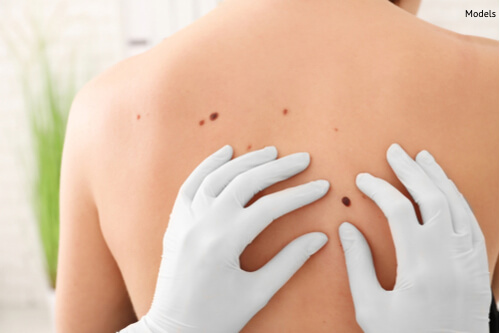Things to Consider When Addressing Skin Cancer
4 Min Read

Get regular skin checkups to ensure that your skin is healthy and receives early treatment if needed.
Skin cancer is a common concern of many Americans, especially those with freckles and fair skin.
The main contributing factor to the formation of skin cancer is ultraviolet (UV) rays from the sun. Tanning beds and other artificial sources of light and heat are also culprits.
While there are some people who have a predisposition or higher risk of being diagnosed with skin cancer than others, almost anyone can develop skin cancer.
Skin cancer can be removed when found and treated early, including more severe cases of melanoma. The key is early detection and being informed.
Below are some details on what to do if you think you may have skin cancer, and what to expect after a cancer diagnosis.
How Is Skin Cancer Identified?
Skin cancer most commonly appears on the face, neck, back, shoulders, and arms.
You can notice when something is different about your skin by performing self-checks and having a loved one help you with harder to see spots, such as your back.
Diagnosing Skin Cancer
When you see your physician for regular checkups, or if you think you may have an issue, they can examine your skin and run tests to see if your concern is skin cancer or not.
If you are diagnosed with skin cancer, your physician will discuss your treatment options with you.
What Is Skin Cancer Treatment?
Typically, the affected tissue is removed from the location or areas where cancer is found.
The removal process will likely leave some scarring in the area of excision.
For patients who are having cancer removed from their face, this can be worrisome.
But it is important to remember that cancer, when left untreated, can spread and cause further damage to the skin and body, so you want to take care of it as soon as possible.
Fortunately, plastic surgeons are able to reconstruct the skin to form a smooth appearance if you require the removal of tissue.
Reconstruction After Skin Cancer
If you have significant scarring after skin cancer removal, reconstruction can restore your appearance. Your treatment may include:
- Prosthetics: features, such as the ears, may need restructuring to create a fuller appearance
- Scar revision: this process reduces the noticeability of scars by smoothing out the skin
- Tissue transference: tissue flaps can be used for areas that have had a large amount of tissue loss
How Can I Prevent Skin Cancer?
In some cases, skin cancer can be avoided by practicing various techniques. Some helpful tips for reducing the risk of developing skin cancer, or catching symptoms early to remove any cancer that does form, include:
-
- Do not intentionally get a tan. Getting a sunburn or a tan is damaging to your skin, whether it is through sunshine or a tanning bed. Tanning also causes premature wrinkles that can significantly age your appearance. Self-tanning lotions can be an excellent alternative if you seek bronze skin.
- Wear sun protection every day. Sunscreen, sunglasses, and protective clothing can shield you from the sun’s damaging rays. Avoid direct sun exposure and liberally apply and reapply your sunblock.
- Get checked regularly by a professional. Notify them of any changes in your skin, such as a new growth or an existing mole growing or becoming painful. It is best to catch these concerns immediately and seek treatment during the early stages.
- Be careful around snow, water, and sand. These surfaces are all very reflective and can cause sunburns. The same goes for an overcast day; the sun can still burn you, so please use protection.
- Conduct self-examinations at home. In addition to regular checkups, you will want to become familiar with your skin and analyze any abnormalities that arise.
The ABCDE Test
According to The American Academy of Dermatology, the warning signs of skin cancer can include:
Asymmetry
Are any of your moles asymmetric? Is one half of the mole a different shape than the other half?
Borders
Are any of your moles irregularly shaped or poorly outlined?
Color
Have any of your moles changed in color or shade? You may notice a tan, brown, black, white, red, or blue coloration. Any variation of color can be a warning sign.
Diameter
Are your moles the size of a pencil eraser or even larger?
Evolving
Have any of your moles or skin lesions changed in size, shape, or color?

Staying in the shade, wearing a large-brimmed hat, and liberally applying sunscreen are great ways to avoid the sun’s damaging UV radiation.
What If I Think I May Have Skin Cancer?
If you believe you might have skin cancer, have been diagnosed with skin cancer, or have already undergone a removal treatment, schedule a consultation with Dr. Wald in Orange County today to discuss your concerns.
You can get in touch online or call us at our Fullerton, CA, office at (714) 312-3549.




